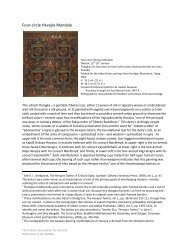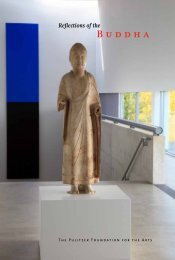Womb World Mandala (TaizÅkai mandara) - Reflections of the Buddha
Womb World Mandala (TaizÅkai mandara) - Reflections of the Buddha
Womb World Mandala (TaizÅkai mandara) - Reflections of the Buddha
Create successful ePaper yourself
Turn your PDF publications into a flip-book with our unique Google optimized e-Paper software.
<strong>Womb</strong> <strong>World</strong> <strong>Mandala</strong> (Taizōkai <strong>Mandala</strong>) 4<br />
priestly robe, or kesa 袈 裟 , now one <strong>of</strong> <strong>the</strong> celebrated treasures <strong>of</strong> Tō-ji 東 寺 temple, Kyoto. 10<br />
Assembled in a patchwork manner from many fragments <strong>of</strong> valuable cloth, <strong>the</strong>se robes are a reminder<br />
<strong>of</strong> <strong>the</strong> mendicant ideal <strong>of</strong> <strong>the</strong> monastic order, and in <strong>the</strong> Shingon 真 語 faith <strong>the</strong>y became important<br />
documents <strong>of</strong> dharma transmission from master to disciple. Upon his return, Kūkai founded <strong>the</strong> Shingon<br />
sect <strong>of</strong> Buddhism and is still revered today as one <strong>of</strong> Japan’s most significant patriarchs. Understood<br />
according its Sino-Japanese characters, “Shingon” means <strong>the</strong> “true word” or mantra; toge<strong>the</strong>r, <strong>the</strong><br />
Shingon sect and <strong>the</strong> Tendai sect 天 台 宗 - which is named for Mt. Tiantai 天 台 山 , in China’s Fujian<br />
province, where <strong>the</strong> teachings were first promulgated - is also <strong>of</strong>ten referred to as mikkyō 密 教 , or <strong>the</strong><br />
“secret teaching”, in contradistinction to kengyō 顕 教 , <strong>the</strong> “revealed teachings.” This kind <strong>of</strong> Buddhism<br />
is known as esoteric (or tantric) because it relies on <strong>the</strong> secret transmission <strong>of</strong> knowledge through<br />
mysterious and elaborate rituals that defy verbal expression. Secret teachings specifically refer to <strong>the</strong><br />
doctrine <strong>of</strong> <strong>the</strong> “secret” <strong>Buddha</strong> Mahavairocana; revealed teachings, to <strong>the</strong> doctrine revealed by <strong>the</strong><br />
historical <strong>Buddha</strong>, Śākyamuni 釈 迦 如 来 (Japanese, Shaka nyorai). 11 <strong>Mandala</strong> are essential to <strong>the</strong><br />
transmission <strong>of</strong> <strong>the</strong>se teachings as visual representations <strong>of</strong> sacred truths that had no o<strong>the</strong>r vehicle:<br />
“Since <strong>the</strong> Esoteric Buddhist teachings are so pr<strong>of</strong>ound as to defy expression in writing, <strong>the</strong>y are<br />
revealed through <strong>the</strong> medium <strong>of</strong> painting to those who are yet to be enlightened. The various postures<br />
and mudras [shown in mandala] are products <strong>of</strong> <strong>the</strong> great compassion <strong>of</strong> <strong>the</strong> <strong>Buddha</strong>; <strong>the</strong> sight <strong>of</strong> <strong>the</strong>m<br />
may well enable one to attain <strong>Buddha</strong>hood. The secrets <strong>of</strong> <strong>the</strong> sutras and commentaries are for <strong>the</strong><br />
most part depicted in painting, and all <strong>the</strong> essentials <strong>of</strong> <strong>the</strong> esoteric Buddhist doctrines are, in reality, set<br />
forth <strong>the</strong>rein. Nei<strong>the</strong>r masters nor students can dispense with <strong>the</strong>m. They are indeed [<strong>the</strong> expressions<br />
<strong>of</strong>] <strong>the</strong> root and source <strong>of</strong> <strong>the</strong> oceanlike assembly”. 12<br />
Kūkai<br />
The Italian scholar Giuseppe Tucci (1894-1984), who was one <strong>of</strong> <strong>the</strong> first Western scholars to focus his<br />
studies on Tibetan Buddhist art and on mandalas, describes mandala as a “means <strong>of</strong> reintegration;” 13<br />
more specifically within <strong>the</strong> Shingon sect, mandala are pictorial attempts to show that all forms <strong>of</strong><br />
10 For a study <strong>of</strong> <strong>the</strong> importance <strong>of</strong> such robes, see Yamakawa Aki, “Intertwined Threads: The <strong>World</strong> <strong>of</strong> <strong>the</strong> Enshoji<br />
Altar Cloth”, in Patricia Fister et. al. Amamonzeki – A Hidden Heritage : Treasures <strong>of</strong> <strong>the</strong> Japanese Imperial<br />
Convents. Tokyo: Sankei Shinbun (1999). This robe was recently on display at <strong>the</strong> Tokyo National Museum<br />
exhibition Kūkai’s <strong>World</strong>: The Arts <strong>of</strong> Esoteric Buddhism (July 20th - September 25th 2011), cat. 17.<br />
11 Minoru Kiyota, “Shingon Mikkyō <strong>Mandala</strong>”, in History <strong>of</strong> Religions, Vol. 8, No. 1 (Aug., 1968), p. 31.<br />
12 Hakeda 1972, pp. 146 - 146.<br />
13 Giuseppe Tucci, The Theory and Practice <strong>of</strong> <strong>the</strong> <strong>Mandala</strong>, trans. Alan Houghton Brodrick. London: Rider & Co.,<br />
(1961) pp. 21-48.<br />
The Pulitzer Foundation for <strong>the</strong> Arts<br />
<strong>Reflections</strong> <strong>of</strong> <strong>the</strong> <strong>Buddha</strong>




